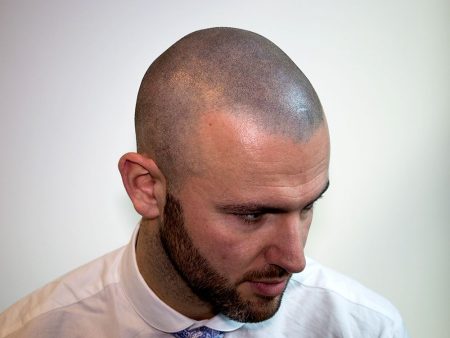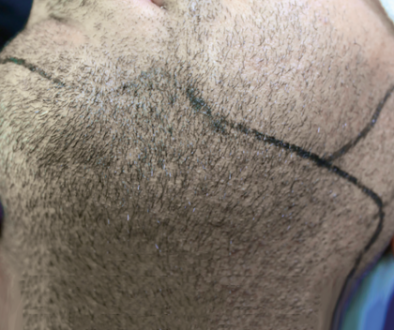Temporary Scalp Micropigmentation (SMP): The Advantages, Disadvantages, and Top Clinics Currently Offering the Treatment
 For the past several years, one of the most anticipated and discussed hair loss treatments has been Scalp Micropigmentation (SMP). Scalp Micropigmentation is a process where a physician or trained technician uses a tattooing process to mimic the appearance of shortly cropped hair on bald or thinning scalp. The process helps create the illusion of increased density in individuals with thinning hair or a “shaved,” “cropped” appearance in those with a completely bald scalp.
For the past several years, one of the most anticipated and discussed hair loss treatments has been Scalp Micropigmentation (SMP). Scalp Micropigmentation is a process where a physician or trained technician uses a tattooing process to mimic the appearance of shortly cropped hair on bald or thinning scalp. The process helps create the illusion of increased density in individuals with thinning hair or a “shaved,” “cropped” appearance in those with a completely bald scalp.
Initially, Scalp Micropigmentation was a permanent process, and technicians/physicians performed the procedure with a permanent, non-fading SMP ink. However, recently several new clinics and practitioners began offering a non-permanent Scalp Micropigmentation process, performed with temporary SMP ink. After learning about the new temporary Scalp Micropigmentation process, hair loss sufferers became even more excited; but the new technique leaves several important questions unanswered: what are the advantages of the new procedure? What are the disadvantages of the new technique? Most importantly, which clinics are offering temporary SMP?
Temporary Scalp Micropigmentation Advantages
Altogether, temporary SMP does offer several distinct advantages over traditional permanent Scalp Micropigmentation:
The first, and possibly most significant, advantage of temporary SMP is that it is not permanent. Unlike traditional SMP, temporary Scalp Micropigmentation only lasts 6 to 24 months (with the average being around 18 months), after which time it slowly fades away and must be applied again. This acts as a significant advantage to those who desire the procedure, but fear the permanent nature, or those who are dissatisfied with the results of the procedure, and would otherwise require laser removal to correct the unsatisfactory work.
Furthermore, most clinics offering temporary SMP do not utilize black pigmentation in tattooing ink, which allegedly decreases the chances of the ink discoloring and turning blue or green over time (as it is normally the black ink that changes color). Additionally, the temporary SMP process involves tattooing the ink into a more superficial layer of the scalp, which allegedly decreases the chances of the ink running, blurring, or losing definition.
Temporary Scalp Micropigmentation Disadvantages
Although the new temporary SMP process does offer some advantages over the traditional, permanent treatment, it does possess several disadvantages as well:
First, and foremost, SMP, in general, is a process that is only ideally suited for a very specific type of hair loss sufferer. In general, individuals with thinning hair looking for density increases akin to those seen with topical concealers, and individuals trying to create the illusion of a “shaved” or closely “cropped” appearance are the “best” SMP candidates. For other types of patients, SMP is not likely advantageous, and should be approached cautiously.
Another disadvantage of temporary SMP is the need to repeat the process every 6 to 24 months. Although many would view this as a positive attribute, it does guarantee additional cost, time, and travel, and may not be realistic for many hair restoration patients. Finally, although temporary SMP ink is designed to fade over time, it’s not completely clear whether or not the tone of the ink will change while fading (possible turning into a blue or green hue), or if the fading ink will result in an “awkward” appearance until completely gone.
Clinics Offering Temporary Scalp Micropigmentation
Now that the potential advantages and disadvantages of temporary SMP are known, it is worth discussing which top clinics are practicing the procedure. Although temporary SMP originally started in Italy, a number of our recommended and Coalition hair restoration clinics are now offering temporary Scalp Micropigmentation. Currently, Feller Medical (Coalition hair transplant surgeon Dr. Alan Feller), Hasson & Wong (Coalition hair transplant surgeons Dr. Jerry Wong and Victor Hasson), Coalition hair transplant surgeon Dr. William Lindsey, and Shapiro Medical Group (Coalition surgeons Dr. Ron and Paul Shapiro) are offering temporary Scalp Micropigmentation.
Altogether, we suggest that hair loss sufferers objectively weigh both the “pros” and “cons” of temporary Scalp Micropigmentation, and then, if satisfied with the information, consider a thorough consultation with one of our recommended hair restoration clinics.
Written and Published By
Bill – Managing Publisher of the Hair Transplant Network, the Hair Loss Learning Center, the Hair Loss Q&A Blog and the Hair Loss Forum.



